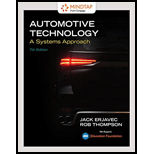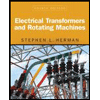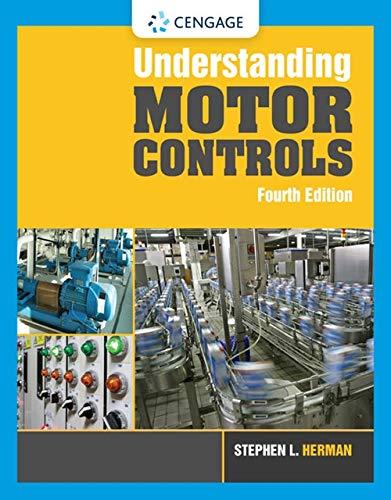
Mindtap For Erjavec/thompson's Automotive Technology: A Systems Approach, 4 Terms Printed Access Card (mindtap Course List)
7th Edition
ISBN: 9781337794381
Author: Jack Erjavec, Rob Thompson
Publisher: Cengage Learning
expand_more
expand_more
format_list_bulleted
Concept explainers
Question
Chapter 18, Problem 1SA
To determine
The purpose of field binding in an electric motor.
Expert Solution & Answer
Explanation of Solution
An electric motor is a device which is used to convert electrical energy into
Want to see more full solutions like this?
Subscribe now to access step-by-step solutions to millions of textbook problems written by subject matter experts!
Students have asked these similar questions
The 2nd Law of Thermodynamics
Refrigerant-134a enters a diffuser steadily as saturated vapor 500 kPa with a velocity of 170 m/s, and it leavesat 600 kPa and 50◦C. the refrigerant is gaining heat at a rate of 2.5 kJ/s as it passes through the diffuser. Ifthe exit area is 75 percent greater than the inlet area, determine
(a) the exit velocity
(b) the mass flow rate of the refrigerant.
2nd Law of Thermodynamics
Refrigerant-134a is throttled from the saturated liquid state at 850 kPa to a pressure of 200 kPa. Determinethe temperature drop during this process and the final specific volume of the refrigerant.
2nd Law of Thermodynamics
An adiabatic gas turbine expands air at 1350 kPa and 525◦C to 125 kPa and 130◦C. Air enters the tur-bine through a 0.15-m2 opening with an average velocity of 50 m/s, and exhausts through a 1-m2 opening.Determine
(a) the mass flow rate of air through the turbine
(b) the power produced by the turbine.
Chapter 18 Solutions
Mindtap For Erjavec/thompson's Automotive Technology: A Systems Approach, 4 Terms Printed Access Card (mindtap Course List)
Ch. 18 - Prob. 1SACh. 18 - Prob. 2SACh. 18 - The part of the armature that the brushes ride on...Ch. 18 - Describe how to perform a starter bench test.Ch. 18 - True or False? The strength of the magnetic field...Ch. 18 - True or False? Worn armature bearings can result...Ch. 18 - Which of the following is not part of the starter...Ch. 18 - Which of the following tests would not be...Ch. 18 - When the starter spins but does not crank the...Ch. 18 - If the solenoid clicks while trying to crank the...
Ch. 18 - Prob. 5MCCh. 18 - Prob. 6MCCh. 18 - Prob. 7MCCh. 18 - The device that prevents the engine from turning...Ch. 18 - A control circuit voltage drop test shows a 1.1...Ch. 18 - An engine cranks slowly: Technician A says that a...Ch. 18 - Prob. 2ASRQCh. 18 - Pinion gear-to-flywheel ring gear clearance is...Ch. 18 - Technician A says that a starter no-load test is...Ch. 18 - Cranking current is excessive but is normal when...Ch. 18 - Prob. 6ASRQCh. 18 - When diagnosing a no-crank no-start condition, no...Ch. 18 - While discussing a no-crank condition: Technician...Ch. 18 - Prob. 9ASRQCh. 18 - While discussing electric motors: Technician A...
Knowledge Booster
Learn more about
Need a deep-dive on the concept behind this application? Look no further. Learn more about this topic, mechanical-engineering and related others by exploring similar questions and additional content below.Similar questions
- The 2nd Law of Thermodynamics Air is compressed from 12 psia and 77.3◦F to a pressure of 145 psia while being cooled at a rate of 15Btu/lbm by circulating water through the compressor casing. The volume flow rate of the air at the inletconditions is 6000 ft3/min, and the power input to the compressor is 800 hp. Determine (a) the mass flow rate of the air (b) the temperature at the compressor exitarrow_forwardI need solution by handarrow_forwardDraw the shear and bending-moment diagrams for the beam and loading shown, and determine the maximum normal stress due to bending. 4.8 kips/ft 32 kips B C D E I Hinge 8 ft. 2 ft 5 ft 5 ft W12 x 40arrow_forward
- The 2nd Law of Thermodynamics A 3.5-m3 rigid tank initially contains air whose density is 2 kg/m3. The tank is connected to a high-pressuresupply line through a valve. The valve is opened, and air is allowed to enter the tank until the density in thetank rises to 6.5 kg/m3. Determine the mass of air that has entered the tank.arrow_forwardTELEGRAM 426 LTE 11. 5:59 Dynamic تم Dynamic Fluids with Applications@le... H.W Q2: The oil tank for a hydraulic system (shown in Fig. 6.5) has the following details: (a) The oil tank is air pressurized at 68.97 kPa gauge pressure. (b) The inlet to the pump is 3.048 m below the oil level. (c) The pump flow rate is 0.001896 m3/s. (d) The specific gravity of oil is 0.9. (e) The kinematic viscosity of oil is 100 cS. (f) Assume that the pressure drop across the strainer is 6.897 kPa. (g) The pipe diameter is 38.1 mm. (h) The total length of the pipe is 6.097 m. Find the pressure at station 2. by Dr. Ali Khaleel Kareem H.W by Dr. Ali Khaleel Kareem Breather Three standard elbows (A, B and C) 3 m Pump Figure 6.5 38 mm (ID) Pipe length = 6m 20 21arrow_forwardA 3 m x 5 m section of wall of the cold room is not insulated, and the temperature at the outer surface of this section is measured to be 7°C. The temperature of the outside room is 30°C, and the combined convection and radiation heat transfer coefficient at the surface of the outer wall is 10 W/m2°C. It is proposed to insulate this section of the furnace wall with glass wool insulation (k = 0.038 W/m°C) in order to reduce the heat transfer by 90%. Assuming the outer surface temperature of the cold room wall section still remains at about 7°C, determine the thickness of the insulation that needs to be used. The company is questioning whether to insulate the section of piping between the evaporator and the compressor. Present (using equations to support your reasoning) whether you would support this idea or notarrow_forward
- Q1.Given the unity feedback system with a forward path transfer function, G(s) = = K (s+1)(s+2)(s+6) . Do the following: (a) Draw the root locus (b) Find the gain, K, and natural frequency for a damping ratio 0.5. (c) Find the range or value of gain, K for i. overdamped ii. critically damped iii. Undamped iv. underdampedarrow_forwardQ. 1: The partial Routh array of a unity feedback system is given below. S6 1 Adel 8 S5 1 S4 2 Bash 6 -4 0 C 0 How many roots does it have in the right half plane? Comment on the stability of the system. Determine the characteristic equation of the system. Q.2: Find the values of Ki and K2 for the system shown in the figure below when Mp=0.25% and tp= 4 sec. assume unit step input. R(S) K₁ C(S) 1+ K₂Sarrow_forwardTemperature EXAMPLE 1: A diesel engine is fitted with a turbocharger, which comprises a radial compressor driven by a radial exhaust gas turbine. The air is drawn into the compressor at a pressure of 0.95 bar and at a temperature of 15°C, and is delivered to the engine at a pressure of 2.0 bar. The engine is operating on a gravimetric air/fuel ratio of 18: 1, and the exhaust leaves the engine at a temperature of 600°C and at a pressure of 1.8 bar; the turbine exhausts at 1.05 bar. The isentropic efficiencies of the compressor and T(K) turbine are 70 per cent and 80 per cent, respectively. Calculate (i) the temperature of the air leaving the compressor (ii) the temperature of the gases leaving the turbine (iii) the mechanical power loss in the turbocharger expressed as a percentage of the power generated in the turbine. Using the values of : Cpair = 1.01 kJ/kg K, Vair = 1.4 Cpex = 1.15 kJ/kg K, Yex = 1.33 and 2s с P2 Engine P3 W W₁ = mexpex (T3-TA) At W₁ = mair Cpex (T2-T₁) 4 P4…arrow_forward
- Problem 8.28 Part A 10 of 10 ■Review The uniform crate resting on the dolly has a mass of 530 kg and mass center at G as shown in (Figure 1). If the front casters contact a high step, and the coefficient of static friction between the crate and the dolly is μs = 0.45, determine the greatest force P that can be applied without causing motion of the crate. The dolly does not move. Express your answer to three significant figures and include the appropriate units. Figure -0.5 m- 0.6 m 0.3 m 0.1 m B 0.4 m 0.3 m > ☐ P = 1210 Submit о ΜΑ N Previous Answers Request Answer × Incorrect; Try Again 1 of 1 < Return to Assignment Provide Feedback ?arrow_forwardQ1: For the system shown in Fig. 6.7, the following data are applicable P1 = 7 bar Q=0.002 m3/sec Pipe: total length 15m and ID 38mm Oil: SG-0.90 and kinematic viscosity (v-0.0001 m2/s) Solve for P2 in units of bars. Motor OH Pump Breather P1 Pipe length = 3m 90' elbow ☐ 38 mm (ID) Pipe length = 2m P2 Load force Pipe length 4 m = Pipe length=6m 90' elbowarrow_forwardusing the three moment theorem please find the moments about B, C and Darrow_forward
arrow_back_ios
SEE MORE QUESTIONS
arrow_forward_ios
Recommended textbooks for you
 Automotive Technology: A Systems Approach (MindTa...Mechanical EngineeringISBN:9781133612315Author:Jack Erjavec, Rob ThompsonPublisher:Cengage Learning
Automotive Technology: A Systems Approach (MindTa...Mechanical EngineeringISBN:9781133612315Author:Jack Erjavec, Rob ThompsonPublisher:Cengage Learning Electrical Transformers and Rotating MachinesMechanical EngineeringISBN:9781305494817Author:Stephen L. HermanPublisher:Cengage Learning
Electrical Transformers and Rotating MachinesMechanical EngineeringISBN:9781305494817Author:Stephen L. HermanPublisher:Cengage Learning Understanding Motor ControlsMechanical EngineeringISBN:9781337798686Author:Stephen L. HermanPublisher:Delmar Cengage Learning
Understanding Motor ControlsMechanical EngineeringISBN:9781337798686Author:Stephen L. HermanPublisher:Delmar Cengage Learning Refrigeration and Air Conditioning Technology (Mi...Mechanical EngineeringISBN:9781305578296Author:John Tomczyk, Eugene Silberstein, Bill Whitman, Bill JohnsonPublisher:Cengage Learning
Refrigeration and Air Conditioning Technology (Mi...Mechanical EngineeringISBN:9781305578296Author:John Tomczyk, Eugene Silberstein, Bill Whitman, Bill JohnsonPublisher:Cengage Learning

Automotive Technology: A Systems Approach (MindTa...
Mechanical Engineering
ISBN:9781133612315
Author:Jack Erjavec, Rob Thompson
Publisher:Cengage Learning

Electrical Transformers and Rotating Machines
Mechanical Engineering
ISBN:9781305494817
Author:Stephen L. Herman
Publisher:Cengage Learning

Understanding Motor Controls
Mechanical Engineering
ISBN:9781337798686
Author:Stephen L. Herman
Publisher:Delmar Cengage Learning

Refrigeration and Air Conditioning Technology (Mi...
Mechanical Engineering
ISBN:9781305578296
Author:John Tomczyk, Eugene Silberstein, Bill Whitman, Bill Johnson
Publisher:Cengage Learning